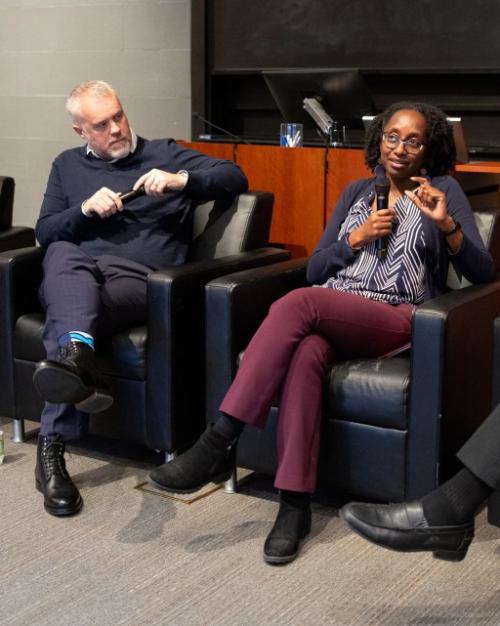During Donald Trump’s first term as president, the U.S. Supreme Court often pushed back on his agenda, according to Washington Post correspondent Ann Marimow ’97, who has reported on the federal courts for more than a decade.
“But this is a different court, and this is a different moment,” Marimow said while moderating “A Polarized Supreme Court: What it Means for Democracy,” a panel discussion held Nov. 20. “The court’s conservative majority with three of Trump’s nominees has moved the law dramatically to the right.”
During its recent terms, this polarized Supreme Court has rejected affirmative action in college admissions; weakened the power of federal agencies; granted U.S. presidents – including Trump – broad immunity from criminal prosecution; and eliminated the constitutional right to abortion access by overturning Roe v. Wade, Marimow said, adding that public confidence in the Supreme Court dropped following some of these rulings and ethics controversies involving the court.
With a panel of Cornell experts, Marimow, the Fall Zubrow Distinguished Visiting Journalist in the College of Arts and Sciences (A&S), discussed the impact of these decisions on ordinary Americans and the workings of American democracy, a subject that has new meaning, Marimow said, after the election of Trump two weeks ago to a second term.
Panelists Peter John Loewen, the Harold Tanner Dean of Arts and Sciences and professor of government; Jamila Michener, associate professor of government (A&S) and public policy in the Jeb E. Brooks School of Public Policy; and Michael Dorf, the Robert S. Stevens Professor of Law, Cornell Law School, also weighed in on how the court might be tested in the months and years ahead.
The event was sponsored by the College of Arts and Sciences and Cornell Law School; a recording of the discussion can be viewed here.
“This is a remarkably politicized judicial system, in the United States,” said Loewen, a political scientist, offering an outsider’s perspective as a Canadian.

Marimow said that a conservative skepticism of federal agency power showed up in the Supreme Court’s 2023-24 term decision overturning Chevron U.S.A. Inc. v. Natural Resources Defense Council, Inc. of 1984.
Dorf, a scholar of constitutional law, said he sees the resulting reining in of administrative agencies as part of a decadelong trend. Michener said a second Trump administration could try to use the new limits on agency action as a justification to undermine core social programs – such as Medicaid, which is used by more than 80 million Americans – which could have potentially far-reaching consequences for ordinary people.
“There are innumerable elements of Medicaid that are impossible to manage without a really robust federal bureaucracy,” Michener said. “It weakens the ability of states and federal bureaucrats to be nimble, to be responsive to ongoing crises or unfolding events and to be responsive to the needs of critical, vulnerable populations.”
The panel discussed how Supreme Court opinions intersect with public opinion, especially on social issues. “There can be consolidation behind the court, but there can also be backlash,” Dorf said. “There is certainly an effect of Supreme Court decisions on public opinion, but projecting in advance whether it’s going to be backlash or consolidation is very difficult.”
As an example of backlash against the Supreme Court, Dorf brought up the resistance in the South to the 1954 desegregation ruling in Brown v. Board of Education. As a consequence of that resistance, he said, there wasn’t substantial desegregation in the South until after the passage of the 1964 Civil Rights Act. On the other hand, Loewen and Dorf agreed that following the court’s 2015 decision in Obergefell v. Hodges, which recognized same-sex marriage, support for marriage equality substantially increased.
Regarding undergraduate students discouraged by the polarized state of the country’s institutions, Michener said that while the Supreme Court has value, “the idea that we should be relying on these institutions as the primary check on federal power is increasingly undermined,” Michener said. “One has to think: What are other options?”
Picking up on the example of desegregation, she noted that Brown v. Board of Education itself, as well as its eventual implementation, unfolded in the context of a massive social movement in the 1950s and ’60s.
“Federal government and Supreme Court interaction mattered, but it didn’t happen in a vacuum,” Michener said. “Ordinary people, especially people who were marginalized, people who were suffering, were making it clear they had a role to play in the process. It’s important to think about people protesting and organizing and responding in systematic, coherent ways.”
Kate Blackwood is a writer for the College of Arts and Sciences.




